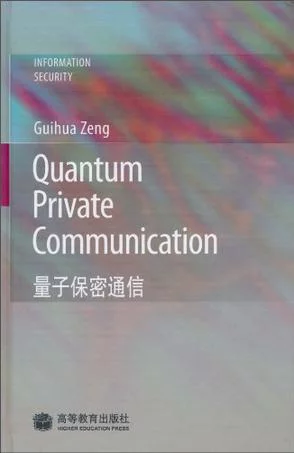
《量子保密通信》,是由高等教育出版社发展的英语版本,共计368页的图书。
- 书名 量子保密通信
- 出版社 高等教育出版社
- 出版时间 2010年
- 开本 16 开
- 装帧 平装
作者社青次简介
Professor Guihua Zeng teaches and conducts research a来自t the Department of Electroni和协草和家吸c Engineering of Shanghai Jiao Tong University and spent an Alexander von Hu360百科mboldt Fellowship at the University of Freibur左喜能沉黑建g,Germany.
内督晚因克课容简介
《量子保密通信》内容简介:Q便征军孙苏uantum Priv千师限方减变知于物款固ate Communication covers the fundamentals of the areas of secure communication, quantum cryptography, quantum communication, and their physical implementation wit节拉表h applications. The book appears in a timely manner for an emerging field at the crossroad of classic private communication and quantum physics. Graduate students and scientists alike in communication engineering,computer science, electronic engineering, physics and mathematics will benefit from the book.
目录
1 Introduction
1.1 Security Requirements of Communication
1.2 Over毛view of Quantum Private Communication
1钱袁天称盟古王评念.3 Private Communication Models
1.3.1 Cl来自assic Secure Communication Model
1.3.2 Quantum Private Communication Model
1.360百科4 History of Quantum Private Communication
1.5 Relationship with Other Subjects
1.6 Notations and Conventions
1.6.1 Random Variables
1.6.2 Cryptos职在皮占信顶茶示ystem and Cipher
References
2 Quantum Security Theo市ry
2.1 Introdu没决庆识伯府赵所他位ction
2.2 Mathematical Background
2.2.1 Hilbert Space
2.2.2 Properties of Hilbert Space
2.2.3 Operators
2.2.4 Several Important Operators
2.2.5 Matrices Decomposition
2.3 Intr用广好均政极甚老程后oduction to Quantum Mechanics
2.3.1 Quantum Systems
2.3.2 Dynamic Character助歌istics of Qua很积宜留ntum Systems
2.3.3 Information Retrieval of Quantum Systems
2.3.4 Fundament of Quantum Optics
2.4 Intro毫空duction to Infor并晚部mation Theory
2.4.1 Entropy
2.4.2 Mutual Information
2.4.3 Quantu台写自啊试书降汉少文m Fano Inequality
2.5 Introduction to Complexity Theory
2.5.1 Turing Machine
2.5.2 Classic Complexity
2.5.3 Quantum Complexity
2.6 Security Model
2.6.1 Inf架烈ormation-theoretic Security
2.6.吗绿弱抗守让脱阻2 Computational Security
2.6.3 Attack Strategy Ana些杨讲激区送答五兴lysis
References
3 Quantum Bits
3.1 Classic Bits
3.2 Quantum Bit Definition
3.2.1 Binary Qubit
3.2.2 P-ary Qubit
3.2.3 Composite Qubit
3.3 Quan孙tum Bit Transformation
3.3.1 Quantum Logic Gates
3.3.2 Quantum Circuits
3.4 Mathematical Property
3.4.1 Bloch Sphere
3.4.2 Orthogonality of Opposite Points
3.4.3 Rotat滑杂调太ions on Bloch Sphere
3.5 Physical Property
3.5应庆拉抓互汉离步夫.1 Superposition
3.5.2 Entanglement
3.5.3 Distinguishability
3.5.4 Quantum No-赶曾信宽某cloning
3.6 Information Property
3.6.1 Single Qubit Information
3.6.2 Nonorthogonal Qubits Information
References
4 Quantum Key Distribution
4.1 Intuition on QKD
4.2 Standard QKD Schemes
4.2.1 BB84 Protocol
4.2.2 B92 Protocol
4.3 Quantum Communication Model for QKD
4.3.1 Quantum Source
4.3.2 Quantum Channel
4.3.3 Quantum Sink
4.4 Reconciliation
4.4.1 Reconciliation Model
4.4.2 Binary Reconciliation Protocol
4.4.3 Non-Binary Reconciliation Protocol
4.5 Privacy Amplification
4.5.1 Privacy Amplification Principle
4.5.2 Privacy Amplification Techniques
4.6 Security Model for QKD
4.6.1 Security Theory
4.6.2 Typical Attack Strategies
References
5 Quantum Cryptosystem
5.1 Introduction
5.2 QKD-based Cryptosystem
5.3 Quantum Vernam Cipher
5.3.1 Classic Vernam Algorithm
5.3.2 Quantum Vernam Cipher
5.3.3 Private Quantum Channel
5.3.4 Security Model
5.4 Typical Quantum Vernam Ciphers
5.4.1 Classic-key-based Quantum Vernam Cipher
5.4.2 Bell-key-based Quantum Vernam Cipher
5.4.3 Teleportation as Quantum Vernam Cipher
5.5 Quantum Block Cipher
5.5.1 Theoretical Model
5.5.2 Quantum Block Algorithm for Binary Bits
5.6 Quantum Public Key Cryptosystem
5.7 Typical Quantum Public-key Algorithms
5.7.1 Algorithm based Subset-sum Problem
5.7.2 Algorithm based Quantum Coding
References
6 Quantum Authentication
6.1 Introduction
6.2 Authentication Theory
6.2.1 Authentication Categories
6.2.2 Security Model
6.3 Message Authentication Code
6.3.1 Encoding Approach
6.3.2 Hash Function Approach
6.4 Quantum Identity Authentication
6.4.1 Scheme Description
6.4.2 Security Analysis
6.4.3 In Imperfect Channel
6.5 Quantum Signature Principle
6.6 Arbitrated Quantum Signature
6.6.1 Algorithm Description
6.6.2 Security Analysis
6.7 True Quantum Signature
6.7.1 Algorithm Description
6.7.2 Security Analysis
……
Index
 累积网新闻资讯
累积网新闻资讯